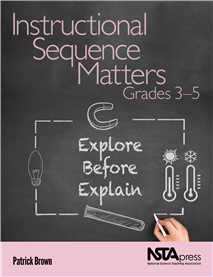All Phenomena resources
eBook
It’s Still Debatable! Using Socioscientific Issues to Develop Scientific Literacy, K–5 (e-book)
It’s Still Debatable! encourages scientific literacy by showing you how to teach the content and thinking skills K–5 students need to explore real-world questions like these: • Is football too dangerous for kids? • Do we need zoos? �...
eBook
Instructional Sequence Matters, Grades 3–5: Explore Before Explain (e-book)
Instructional Sequence Matters, Grades 3–5 is a one-stop resource that will inspire you to reimagine how you teach science in elementary school. The book discusses two popular approaches for structuring your lessons: POE (Predict, Observe, and Expl...
Blog Post
Helping Students Take Control of Their Learning
I am responsible for teaching my students how to think, learn, solve problems, and make informed decisions. I firmly believe that science is everywhere and affects all aspects of our daily lives, from the food we eat to the way we communica...
By Cindy Abel
Blog Post
Under Indefinite Construction: Creating an NGSS-Friendly Classroom Community
When the Next Generation Science Standards (NGSS) were first released, I struggled with how to create opportunities that allowed the students to investigate and question. These standards ask alot of our students and require more planning an...
By Megan Rowlands Elmore
Blog Post
I first encountered the KLEWS teaching strategy in an article in Science and Children (NSTA 2015), “KLEWS to Explanation-Building in Science.” I shared the article and modeled the strategy with teachers who wanted to support their K–5 students ...
Blog Post
Impact of Change by Jessica Holman and Michelle Schuster
If you were to walk into our classroom years ago, you would see students from all walks of life, and with a range of ability levels. All of the students were blended together to learn science and were eager to be engaged. We were teaching units that ...
By Cindy Workosky
NSTA Press Book
A Head Start on Science, Second Edition: Encouraging a Sense of Wonder
Imagine what fun it could be for 3- to 7-year-olds to engage in a game of Prism Play or Magnetic Scavenger Hunt or Where Did the Shadows Go? Then imagine how convenient it would be for you if such activities came with the connections, standards, and ...
By William C. Ritz, William Straits
NSTA Kids
This book will get young readers buzzing about bees! Next Time You See a Bee reveals the big impact these little insects have on the world. It shows how the physical features of bees make them pros at collecting and spreading pollen. It explains how ...
NSTA Kids
Click here to view video of Never Stop Wondering Celebrate imagination! This NSTA Kids book has been selected for the Children’s Book Council #ImaginationCelebration Showcase! Full book list: Imagination Celebration Showcase Never stop won...
Blog Post
Elementary Science—Best Practices for All Students
Envision a room filled with noise, excited whispers, and students shouting across tables. Piles of tinfoil, plastic cups, scissors, string, and tape are scattered around the room. Paper, pencils, and notebooks filled with sketches are strewn across g...
By Cindy Workosky





